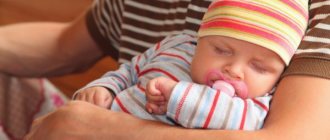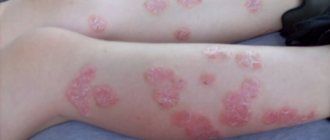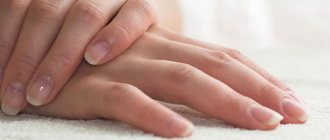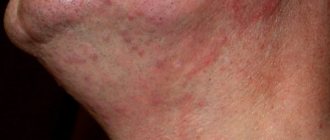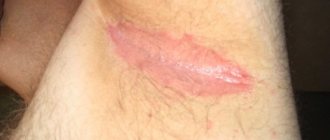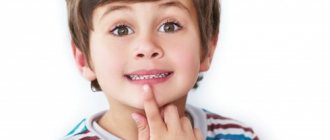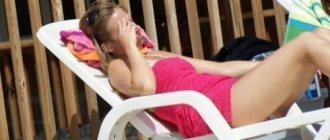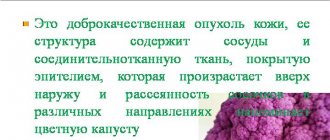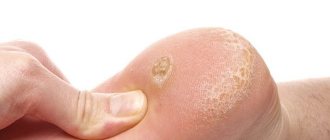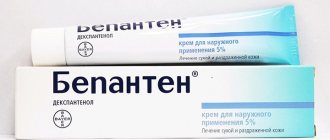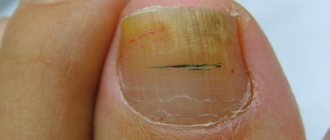Types of mycosis
In nature, there are four types of mycosis:
- Keratomycosis is infection of certain areas of the skin, including the hairy area (in the form of lichen or flaky skin): head, foot, nails;
- Candidiasis - rashes on the genitals or internal organs, on the mucous membrane of the mouth (irritation of the tonsils, throat) and nasal cavity;
- Deep mycosis – the skin surface, part of the internal organs (feet, arms, legs, head area, nail plates, etc.) are affected;
- Dermatomycosis is an infection that affects areas of the skin (feet, legs, arms, nail plates, etc.), throat, tonsils, and head.
The most common areas affected by infection are the feet, head area, arms and face. The question arises: where do young patients get such an insidious disease?
Causes
Mycosis of the skin (hands, feet, scalp, etc.) and nasopharynx (throat, tonsils) has a number of causes:
- Long-term treatment with medications;
- Poor ecology (increased levels of radiation, polluted airspace);
- Poor nutrition (increased consumption of sweets, salty foods, etc.);
- Presence of congenital diseases;
- Lack of hygiene.
Fungal infections often occur in premature babies due to intensive drug therapy, including antibiotics.
There are quite a few cases where the cause of mycosis in a child was pets. Cats, dogs and a number of other pets are carriers of infection, so with close contact, children may well become infected from them.
Symptoms
Mycosis is accompanied by the following symptoms:
- Itching, burning, redness of smooth skin;
- With candidiasis, damage to the tonsils and throat is observed;
- The appearance of cracks on the surface of the skin, which subsequently begin to peel off;
- Affected areas of skin take on a scaly appearance;
- Red or gray spots appear on the scalp, accompanied by burning and itching;
- The appearance of red blisters on the surface of the skin.
Mycosis also includes thrush. It appears in children at an early age. It is characterized by the presence of a white coating over the affected areas of the skin. With mechanical impact, this area may begin to bleed. Infants develop a rash in areas of close contact with a diaper or diaper.
More often in nature, mycosis of smooth skin occurs in a child: microsporia, mycosis of the feet (hands, nails), athlete's foot, lichen, candidiasis and trichophytosis.
When the first symptoms appear, you should contact your treating pediatrician. Because in the case of mycosis, it is very important to start timely treatment.
Main symptoms
Redness of the thumb
You should begin treatment for foot fungus immediately after discovering the first signs of the disease in your child. A fungal infection has fairly recognizable symptoms that prevent it from being confused with something else. Among them, it is worth highlighting two main ones:
- The disease leads to the formation of scales on the epidermis, especially noticeable between the fingers. Such scales, remaining in shoes, become a cause of infection of the feet and can provoke the primary development or relapse of mycosis.
- The skin changes, blisters and erosions appear. Often the epidermis changes its natural pinkish color to yellowish. The intensity of the pathological color and the shade variant depend on the type of fungus that caused the disease.
In addition, very often children begin to complain of burning, itching in the foot area, and sometimes pain when walking. This set of symptoms is an alarming signal and requires immediate contact with a dermatologist. Treatment of foot fungus in children is best done under the guidance of a doctor, since the development of infection leads to serious consequences for the child’s body. In addition, the skin suffers greatly - ulcers and blisters turn into deep, inflamed cracks that make it difficult to walk.
The infection does not stand still and gradually spreads along the foot, covering an increasingly larger area and aggravating the clinical picture. Without proper treatment, mycoids penetrate the circulatory system.
Diagnostics
Diagnosis of mycosis is carried out by a dermatologist or mycologist, depending on the areas affected by the fungal infection. To make a final diagnosis it is necessary to conduct a series of clinical studies.
For mycosis of smooth skin, sometimes a part of the scale is taken from the damaged area. The sample is treated with special reagents and then carefully examined under a microscope. During the process, doctors can take photos of the pathogenic environment to study the pathogen in more detail. But more often cultural practice is used. Based on the taken scales, the fungus is grown in a nutrient medium for it.
The causative agent of mycosis of smooth skin is red trichophyton, less often - interdigital trichophyton. These harmful microorganisms affect the feet or appear in the scalp.
When diagnosing mycosis of the throat and tonsils, microscopic examination of plaque is carried out, and the nature of the infection is carefully studied. Its causative agent is the fungus Candida. During the research, medications are prescribed.
Treatment
Treatment of mycosis in a child takes place in several stages.
- If smooth skin (feet, head, nails, etc.) is affected without inflammation of the scalp, it is recommended to treat the infection areas with a two percent iodine solution every morning. Iodine disinfects and promotes healing;
- In the evening, you should apply an ointment that will moisturize the infected area and relieve itching during sleep. Most often, such ointments contain the following components: nystatin, miconazole and amphotericin A;
- Creams, suspensions, and gels also help with mycosis of smooth skin. They are used as Mikozolon, Mikoseptin, or Mifungar cream. But before using them, you should consult your doctor.
You can read in detail the instructions for a particular drug on the Internet, presented in the form of a photo, or posted on medical portals.
- Recommended reading: foot fungus in children
If there is an infection on smooth skin and hairy surfaces, the doctor will prescribe antifungal antibiotics, such as Griseofulvin.
The daily intake for a child is calculated based on the formula 22 mg per 1 kg of child weight. The medicine is taken together with vegetable oil after or during meals. Subsequently, the removal of the keratinized layer of the epidermis or the infected scalp is carried out using the “sealing” method. The affected area is covered with adhesive tape for about two to three days, which causes increased aggravation but makes it easier to remove the hairs.
Infection of the foot with mycosis in a child requires special treatment. After all, if you do not start timely therapy, then the nail plate may also suffer. One of the most popular remedies in this case is Lamisil. It has a disinfecting effect, moisturizes the feet, and also strengthens the nail plate. But it is only indicated for children over 12 years of age. For babies, you can use Pimafucin cream or Mikospor solution.
Treatment of mycosis of the throat and tonsils is carried out with antifungal agents. Including fluconazole, nystatin or levorin. If treatment for the tonsils and throat is not started in time, the infection may spread further, causing unwanted complications.
An important stage on which the treatment is based is the disinfection of the young patient’s bedding and clothing.
To do this, you need to boil things in a one percent soda solution with added soap for 15-20 minutes. For one liter of water, take 10 grams of soap and 10 grams of soda. The fabric surface of upholstered furniture and outerwear should be ironed or steamed several times.
The effectiveness of smooth skin treatment is tested using a fluorescent lamp. It helps determine the presence of fungus and track progress after starting drug therapy. A patient is considered healthy if there is no luminescent glow on a smooth area of skin.
Treatment of mycoses
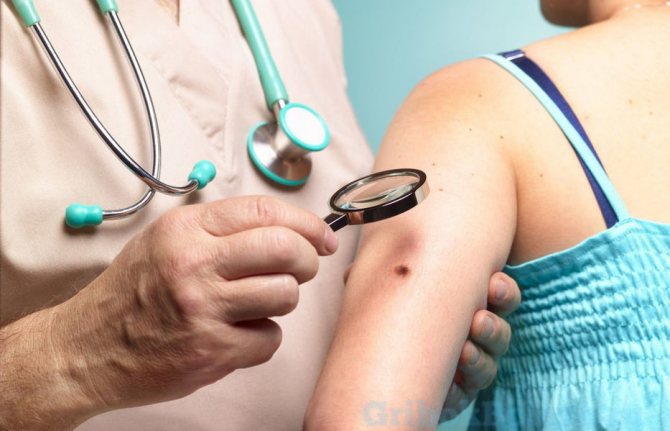
Treatment of mycosis of smooth skin with elements of a rash is carried out using local antiseptics, ointments and creams for fungus and, if necessary, using systemic antimycotics.
Some drugs for treatment:
- Fukortsin;
- Potassium iodide;
- Chlorhexidine;
- Ketoconazole;
- Terbinafine;
- Nizoral;
- Exoderm;
- Lamisil;
- Itraconazole;
- Nystatin;
- Ketoconazole tablets.
Folk remedies can cure initial lesions of the skin; for treatment they usually use:
- tea tree oil;
- Birch tar;
- hydrogen peroxide;
- laundry soap;
- Apple vinegar;
- ammonia.
Prevention
The main preventive measure for mycosis is maintaining complete hygiene.
Before coming into contact with a newborn baby, you must wash your hands thoroughly, because through them the fungus can get to the child. Further, the disease is highly likely to spread to the skin (on a hairy or smooth surface) or in the nasopharynx area (damage to the tonsils). If there is a tendency to such a disease, doctors prescribe the drug Nystatin for prevention. However, its 100% effectiveness has not yet been proven.
Premature babies taking medications and antibiotics are at increased risk. To prevent the disease, they are given fluconazole during the first two weeks of their life. But such therapy is prescribed only by a doctor, because This drug is not recommended for children under 16 years of age.
- Be sure to read: nail fungus in children
Mycosis is not a simple disease. To cope with it without serious consequences, you need to start treatment on time. And then the child will avoid problems associated with this disease in the future.
source: LechenieDetej.ru
In recent decades, fungal infections have become quite widespread, and fungus in children, unfortunately, has ceased to be rare. This is caused by both wider contacts of children with the external environment (school, swimming pool, various sports sections, long excursion trips with hotel accommodation), and a decrease in the level of immune defense of the child’s body, due, among other things, to the general deterioration of the environmental situation, especially in large cities.
Types of fungal infection
Mycosis in children, as in adults, can affect various parts of the body. Most often this happens to the skin, nails and hair, since they are the ones that are designed by nature for constant close contact with the outside world.
The causative agents of fungal diseases are divided into:
- anthropophilic (passing only from person to person);
- zoophilic (the source of infection is a sick animal or its fur, as well as a person infected from it);
- geophilic (extremely rare, spores parasitize the soil).
The most common types of this infection in children are various forms of lichen (ringworm, pink, pityriasis versicolor), as well as the so-called superficial candidiasis, which occurs as a result of the activity of pathogenic microflora of the genus Candida. Yeast fungus in children affects not only the skin, but also the mucous membrane. As yeast multiplies, it causes a white coating to appear on the tongue, gums, and inner surface of the cheeks.
Onychomycosis - a fungal microflora that affects the nail plate and causes a change in the color of the nail and its deformation - is also a common phenomenon, the risk of which usually increases in adolescence due to the expansion of the sphere of communication, visiting holiday camps, playing various sports that involve the use of common showers and locker rooms .
Symptoms of foot fungus in children
Most parents think that the risk of contracting a fungal infection before attending kindergarten is low. This opinion is erroneous, because most often this disease occurs in children from birth to 14 years.
Onychomycosis is very dangerous because in the early stages it has no pronounced symptoms. Therefore, it is very important that parents recognize nail fungus in children in time and contact a specialist.
The disease manifests itself as follows:
- A white coating appears on the nail plate;
- The pads of the fingers and feet become swollen and inflamed;
- Toenails gradually change color from gray to black, grooves appear;
- The skin on the foot becomes hard, cracks appear between the toes;
- The nail plate becomes fragile, nails crumble and break.
As a result, the fungal infection completely destroys the nail. The disease spreads to the adjacent nail plate and affects the skin of the foot.
Toenail fungus appears between the toes and manifests itself with the following symptoms:
- Peeling, blistering and rash on the skin;
- Blisters that begin to crack;
- Itching;
- Burning;
- Redness;
- Erosion.
Also, the child will complain of pain when walking.
The disease can manifest itself in the form of blistering or spotty rashes in the spaces between the toes or on the foot.
Typical symptoms of mycosis on the legs include:
- itching;
- unpleasant odor;
- peeling of the skin;
- red spots;
- thickening of nails;
- bubble formations;
- purulent inflammation (with the addition of secondary infections).
We suggest you familiarize yourself with Massage after bunion removal
When a fungal infection occurs, newborns have a fever, become whiny, sleep poorly and refuse to eat. Fungus on children's toes is manifested by swelling and redness of the skin. Over time, numerous scales appear in the affected areas and begin to peel off.
Onychomycosis is characterized by damage to the nail plates. The disease is indicated by their deformation, thickening, separation and color change. If left untreated, the periungual tissues become inflamed, causing severe discomfort. Due to disruption of biochemical processes, the subungual skin becomes thinner, and the nail itself is separated from the nail bed.
How does infection occur?
The main way of transmitting pathogenic microflora is contact with a sick person (his things) or an animal (or his fur). During childhood, human tissues are characterized by certain qualities that facilitate the penetration of fungus into the body.
These include:
- increased ability of children's skin to absorb moisture;
- more intense blood supply to tissues than in adults;
- tenderness and vulnerability of the epidermis;
- weak bactericidal properties of sebum and sweat secretions.
Due to their age, children are not able to understand the degree of risk of contact with potentially dangerous objects and subjects and the need to carefully observe the rules of personal hygiene.
In addition, the child’s body is much more vulnerable to such negative factors as poor ecology, stress, vitamin deficiency, chronic inflammatory processes, long-term use of antibiotic drugs, especially uncontrolled. In this case, it is possible to activate the so-called opportunistic fungi, which constantly live on the human dermis, but do not manifest themselves in any way with stable immune protection. And then a fungus may appear in a child even in the absence of obvious sources of infection.
All these factors taken together contribute to the fact that, under the same circumstances, it is much easier for a small person to “catch” a skin fungus, as well as other forms of the disease, than for an adult.
Symptoms and diagnosis
The first fungal symptom in the skin form is redness and itching of the affected areas, as well as the appearance of various types of rashes on the surface of the epidermis. However, since similar signs can also occur with other forms of skin lesions - allergies, contact dermatitis, etc., only a specialist can establish an accurate diagnosis. Therefore, the first thing parents must do when problems of this kind arise is to consult a doctor.
The main methods for diagnosing fungal pathologies include:
- Irradiation with a Wood's lamp (in its rays, the affected dermis changes its color, acquiring a golden yellow, bright green or red hue, depending on the type of pathogenic microorganisms parasitizing on the child's skin).
- Bacterial seeding, which allows you to propagate spores in order to study them under a microscope and determine the type of pathogenic microflora.
- Scraping samples of affected tissue to examine them in the laboratory to determine the reaction of the mycelium to drug therapy.
- PCR is the most modern method, which involves determining the type of fungus based on the determination of its DNA.
After establishing an accurate diagnosis, the attending physician develops a regimen for the use of certain medications necessary to combat the disease.
Measures to prevent fungus in children
Preventing fungus on the hands and feet in children is easier than treating it. For these purposes, simple but quite effective measures are needed:
- regularly disinfect toys, children's things, and child's shoes;
- select clothes and shoes according to size, from natural materials;
- limit the child’s contact with street animals and, if necessary, with domestic animals;
- use special shoes for swimming pools and baths, and avoid walking barefoot on the street;
- monitor the cleanliness of hygiene supplies, use an individual manicure set.
Adults must monitor compliance with these measures and the state of health; the child is not capable of such a degree of self-control and cannot always correctly assess the danger of certain actions.
Treatment strategy
Treatment of fungus in children requires a particularly careful approach, since the reaction of the child’s body to pharmaceutical drugs can be very different from how it occurs in adults. It must be carried out under the strict supervision of a specialist, and self-medication in this case is especially dangerous.
If there are concomitant pathologies that complicate the course of a fungal skin infection in children, or in the case of highly contagious forms (ringworm and some others), the attending physician may recommend hospitalization, which should not be refused. If the disease proceeds without complications and allows the course to be carried out without strict isolation of the patient, treatment can be done on an outpatient basis.
In the initial stage, good results are achieved by using external dosage forms - ointments, creams, sprays.
The most effective effects are shown by the following:
- Ketoconazole;
- Miconazole;
- Clotrimazole;
- Econazole;
- Terbinafine;
- Lamisil.
If the therapeutic effect of contagious pharmaceuticals is insufficient, oral medications may be prescribed. Diflucan is an effective remedy against mycoses in children. The children's form is a suspension with an orange flavor, which is used both for internal use and for lubricating the oral cavity in case of damage to mucous tissues. Griseofulvin is another effective fungicidal drug, also available in both tablet and suspension form.
In children, treatment of fungal pathologies usually occurs fairly quickly, provided that all instructions from the attending physician are followed, as well as strict adherence to preventive measures to prevent re-infection. The main rule in this case is careful personal hygiene and sterilization of all household items that in one way or another touch the lesions. It is worth noting that when boiling, pathogenic spores die within 3-5 minutes.
source: mirmedikov.ru
The nature and severity of mycosis are divided depending on the type of fungus and the area affected. The development of mycosis is facilitated by diseases that result in a general decrease in the body’s immunity. During this disease, various areas of the skin are affected. There are several types of mycosis:
- keratomycosis - fungi affect the surface of the skin and manifests itself in the form of lichen and flaky skin; candidiasis - fungal infection of the mucous membrane of the mouth, nasopharynx, vagina, internal organs;
- deep mycosis – all areas of the skin and internal organs are severely affected;
- dermatomycosis - damage to the skin, nails, and hair is observed.
Since the main carriers of mycosis are cats, dogs and some other animals, children are most often infected with mycosis due to closer contact with a sick animal.
Antimycotic agents for topical use in children
Mikozan
Mycosan forms a protective film on the surface of the nail plate, strengthens it and becomes a barrier to the pathogen. If the nail is affected by a fungus, the product has a detrimental effect on microorganisms, preventing their further growth and reproduction.
In the treatment of children, the drug can be used starting from 4 years of age. It must be used for at least a month, applying the product morning and evening to the nail plates.
After completing the main course, continue to use the medicine once during the day until a healthy nail grows completely. The first visible effect appears after a couple of weeks.
Lamisil
An antifungal cream that is effective for skin mycoses, candidiasis, and lichen versicolor. The product is approved for use by children aged 12 years and older.
It is recommended to apply the cream to cleansed skin twice a day. Treatment with the drug is usually short-term - on average it lasts 1-2 weeks. The effect appears already in the first days of therapy.
Amorolfine
An antimycotic agent that is recommended for the treatment and prevention of onychomycosis, dermatomycosis, infections caused by yeast and mold fungi. The drug is available in the form of cream, spray and varnish. The main component has a detrimental effect on the cell membrane of the fungus.
. The drug can be prescribed to children over 3 years of age. It is applied to the infected areas twice a day until complete recovery.
Amphotericin B
Antifungal ointment for external use. Used for candidiasis of the skin and mucous membranes of the mouth. Allowed for children from one year of age. The average course of treatment is 2 weeks. The ointment is applied to the affected areas two to four times a day. An occlusive dressing cannot be applied to the treated areas.
Symptoms of mycosis
Mycosis in children is accompanied by the following symptoms:
- the occurrence of itching and burning pain;
- the appearance of cracks in the skin followed by peeling;
- the skin in infected areas becomes dry and scaly;
- the appearance of itchy red or gray spots on the scalp;
- the appearance of wet reddish spots with small red bumps.
Treatment of mycosis in children
Mycosis in children is treated as follows: the infected areas are treated with a 2% iodine solution in the mornings for two weeks, and in the evenings with nystatin, levorin or mycosporic ointments. For a common form of mycosis, a course of nizoral is recommended, the dosage of which is 200 mg per week, and external treatment of the skin and scalp with a 4% boric acid solution is also used. For preventive purposes, the patient's underwear, clothing and bed linen are disinfected. To prevent the occurrence of mycosis in children, they should be protected from contact with infected animals that have the following external signs of the disease: areas of baldness on the forehead, temples, ears, areas of bald patches on the body and legs, on the neck and back.
source: mamochki-detishki.ru
A person of any age lives surrounded by various microorganisms, but normal immune status inhibits the development of pathogens of most diseases. Causative agents of fungal infections are no exception - it is impossible to limit contact with them, because without these representatives of the microflora many processes surrounding humans are impossible.
Features of fungal infections in children
Mycoses in children occur no less frequently than in adult patients, but the course of these diseases in young patients has its own characteristics - some of the fungal infections, for example, trichophytosis and microsporia, occur very often, others (athlete's foot or pityriasis versicolor) - relatively rarely.
It is also important to remember that the causative agents of diseases can be both opportunistic organisms that are present in the body, but remain inactive, and unconditionally pathogenic ones - their contact with the skin and its appendages always causes the appearance of signs of mycosis, but the severity of the symptoms also depends on the condition immune system of a small patient.
That is why the appearance of symptoms of such a fungal disease as candidiasis requires careful attention from parents - this disease indicates the development of immunodeficiency and concomitant dysbacteriosis, which, in turn, leads to very unpleasant consequences. Accordingly, treatment will require not only the use of antifungal agents, but also the mandatory restoration of the immune system.
In the case when a child exhibits manifestations of trichophytosis and microsporia, in the overwhelming majority of cases such a disease does not remain isolated - outbreaks of these diseases occur frequently in organized children's groups, and domestic animals become the most common “primary” sources of infection. Therefore, during the treatment process, it is important not only to simultaneously prescribe treatment for all sick people, but also to look for an infected animal, limit contact with it and treat the pet (at the veterinarian).
Athlete's foot, especially damage to the skin of the feet, occurs less often in children than in adult patients - children exchange their shoes much less often (which cannot be said about clothes and hygiene items), and visit saunas and swimming pools less often. The appearance of symptoms of lichen versicolor, a fungal skin disease with a relatively favorable course, is associated with the presence of this infection in the family, and with this mycosis, it is not so much treatment that is important as limiting the possibility of infection of the child.
Causes of foot fungus in children
Many parents wonder whether infants get mycosis of the feet? Infection at this age can occur when there is an infected person in the family. The fungus is transmitted by contact through shared household items. Most often, infection in a child under 3 years of age occurs from an infected parent.
In addition, the appearance of mycosis in a one-year-old child and children 2 years of age can be provoked by other factors:
- physiological features of the structure of the interdigital space (tight spaces between the phalanges);
- genetic predisposition to infectious diseases;
- violations of the protective function of the skin;
- congenital pathologies (flat feet, vascular diseases).
This is what foot fungus looks like in a child
In older children - 4 years old, 5 years old - infection with a fungus can occur due to violation of hygiene rules. Often a child puts on someone else’s shoes in kindergarten, when visiting, goes to the pool or gym without a change, or runs barefoot down the street.
The infection activates especially quickly if there are minor abrasions or other damage to the skin of the feet. Through microtraumas, bacteria easily penetrate the epidermis. This happens when wearing uncomfortable and tight shoes.
Past infectious diseases are also the cause of mycosis or onychomycosis (damage to the nails). At this time, immune forces are significantly reduced, and the body is not able to cope with the fungus.
Young children often suffer from fungal diseases, which is associated with the immaturity of the immune system. The infection enters the body through microdamages on the legs, causing allergic reactions, peeling, the formation of spots, papules (cavity-free nodules), and blisters. Fungus on the feet of children occurs due to a decrease in the body's defenses and a violation of the barrier function of the skin. Factors that provoke its development include:
- violation of personal hygiene;
- vitamin deficiency;
- wearing tight shoes;
- foot hyperhidrosis;
- endocrine disorders;
- vascular diseases;
- flat feet;
- wearing socks made of synthetic fabrics;
- changes in the chemical composition of sweat;
- overweight.
Also, the causes of fungus include immunodeficiency states caused by exacerbations of chronic diseases and hypovitaminosis. The infection is transmitted through household contact, so the risk of mycosis increases with frequent visits to swimming pools, baths, and locker rooms at sports complexes.
In childhood, the following forms of fungus are most often diagnosed:
- Interdigital mycosis. Lesions form in the spaces between the toes on the feet, causing burning and peeling of the skin. If left untreated, cracks and blisters filled with pus appear. When walking, injuries to the legs cause severe discomfort and pain.
- Vesicular mycosis. The fungus primarily affects the feet and areas between the toes. Its development is evidenced by numerous bubbles forming on the sole. Gradually they increase in size and burst, leaving wet ulcers. Open wounds increase the risk of secondary infections, which is why ulcers often appear on the legs.
- Athlete's foot. A rare form of mycosis manifests itself in the form of a scaly “mark” covering the entire foot. In addition to the skin, nails are often affected by the fungus, which leads to their thickening and splitting. The skin is completely covered with keratinized yellow-brown scales, which is why the foot resembles a bird's beak.
- Erased form. The disease occurs in a latent form for a long time, affecting only the interdigital spaces. Over time, the skin becomes covered with a rash and swells, and the nail plates become deformed.
Children often ignore the primary manifestations of fungus (peeling, burning), which complicates its timely diagnosis. Delayed treatment of mycoses entails serious complications in the form of allergic reactions, dermatitis and purulent inflammation.
Measures to prevent fungal diseases in children are practically no different from recommendations for adults.

According to statistics from dermatovenerological clinics, 80% of children become infected with nail fungus in the family. The remaining 20% of cases are caused by plate injuries and occurred while the child was attending preschool.
Children's fungus is activated when the body's defenses are greatly reduced and personal hygiene is not observed. To prevent infection, you must:
- refuse shoes that are too narrow and uncomfortable;
- wear socks made from natural materials;
- treat infectious diseases in a timely manner;
- use rubber slippers in locker rooms and swimming pools;
- Treat shoe insoles with Chlorhexidine at least 2 times a month;
- strengthen the immune system with fortified dietary supplements;
- use antiseptic powders against sweating;
- undergo vitamin therapy 1-2 times a year.
Preventive examinations by a dermatologist help identify mycoses at the initial stage of development. Children with immunodeficiency conditions should visit a doctor 2-3 times a year, especially in the spring and autumn. You should also provide your child with personal hygiene items. Using tar or laundry soap reduces the risk of developing infection by 2-3 times.
Fungal spores love dampness, darkness, and lack of oxygen. They also easily penetrate into a healthy body through cracks and wounds on the skin. Basic list of causes of infection:
- one of the family members is a carrier;
- neglect of personal hygiene rules;
- walking barefoot in places with high humidity and large crowds of people (bathhouse, swimming pool, shower, locker room);
- use of contaminated manicure instruments;
- wearing someone else's slippers, shoes made of synthetic, poorly breathable material.
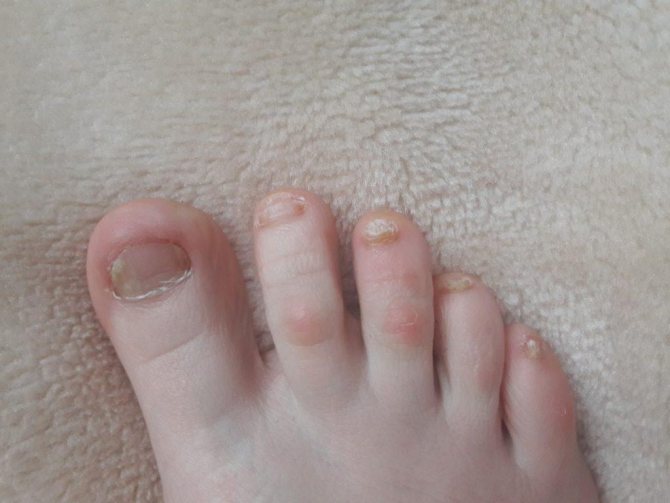
The scientific name of the fungus is onychomycosis.
Infection with it, as well as active reproduction of microorganisms, is possible for the following reasons:
- The baby’s feet sweat a lot as a result of internal disturbances in the body’s functioning or overheating;
- Flat feet;
- Contact with an infected person;
- Damage to the nail plate;
- Weak immunity;
- Avitaminosis;
- Diabetes;
- Poor nutrition – lack of protein, as well as a large amount of sweets, preservatives, and carbohydrates in the baby’s diet.
To avoid this unpleasant disease in a child, you need to follow hygiene standards and also avoid contact of the baby with infected people and stray animals.
Drugs used to treat mycoses in children and features of their use
To treat mycoses in children, the same medications are used as for treating adults, but the process has its own characteristics.
Mandatory rules for the occurrence of signs characteristic of any mycosis in children should be:
1. Mandatory examination by a qualified dermatologist - only a doctor must make a diagnosis (clinically and laboratory), prescribe medications, select the route of administration and treatment regimen.
2. Before prescribing treatment, a comprehensive examination of the child is required - some drugs used to treat fungal infections can have adverse effects on the body, and it is important to monitor the treatment process.
3. The duration of taking drugs orally or locally depends on the type of pathogen and the severity of mycosis.
During the treatment process, antimycotic drugs (fluconazole or clotrimazole), antibiotics with antifungal action, and auxiliary agents are used.
source: www.vse-pro-detey.ru
Parents complaining about any skin symptoms in their child are common cases in pediatric practice. In 40-60% of cases, the cause of complaints is fungal diseases.
Is treatment given to children of different ages the same?
Treatment for fungal toenail infections in children depends not only on the stage of the disease.
Age decides a lot:
- It is not recommended to use medications for children under one year of age, as this can cause great harm to health. In such cases, traditional medicine methods are mainly used;
- From one to two years, you can already use maintenance therapy, namely varnishes, ointments, solutions;
- And only for older children can complex medications be used, such as antifungal drugs, vitamins, and disinfectants. The only limitation is that complex therapy is contraindicated for liver diseases.
Types of fungus
Nail fungus (onychomycosis) in a child
According to the depth of skin damage, fungal diseases in children are divided into the following types:
- Damage to the upper layer of skin, as well as hair and nails (keratomycosis) differs in that the infectious process does not spread to the deeper layers.
- Damage to the epidermis (dermatophytosis) is characterized by a more or less pronounced inflammatory process and dysfunction of the skin.
- Candidiasis or thrush (infection with a yeast-like fungus of the genus Candida) develops on the surface of the skin, changing its pH and suppressing the activity of microorganisms beneficial to humans.
- Deep mycoses is a general term for any of the listed types of fungus, which is used for severe skin lesions or a long course of the disease, in which, for example, the fungus in a child’s groin penetrates deeper than the epidermis.
Forms of fungus on the foot
There are four types of skin lesions caused by fungal spores on the feet of children. Their main characteristics are given in the table.
| Classification | What is the difference |
| Interdigital (intertrininous) | cracks, funnels with a diameter of 3-5 mm between the fingers, flaky edges of the affected areas |
| Moccasin foot (athlete's foot, squamous) | circular or lamellar peeling on the skin, which resembles flour in structure, the foot itches, the fungus spreads to the nails |
| Dyshidrotic (vesicular) | blisters are localized under the bases of the toes, along the outer and inner arch of the foot, on the sole. After ripening, the blisters open, forming weeping ulcers. It can be complicated by bacterial or viral infections and spread higher up the leg, up to the knee. |
| Erased | microcracks in the areas between the fingers, peeling similar to powdery white scales |
Foot fungus is classified according to the location of the spores:
- interdigital;
- plantar;
- dyshidrotic dermatophytosis (covering an area of the body with blisters that resemble in appearance the symptoms of allergic dermatitis);
- deep mycosis (affects not only the superficial, but also the deep layers of the skin);
- onychomycosis (localized on the nails, spreads to the fingers).
A high percentage of moisture in children's skin provokes an accelerated exchange of minerals and lipids in it. The rash and clusters of blisters progress to weeping and swelling.
Areas most commonly affected by fungus
Thrush in a child photo
Most often, the scalp, large folds of the body and smooth skin are exposed to infection in children. Infection can occur through contact with sick animals and people, through water and soil, but the most likely route for the fungus to spread is through objects and surfaces contaminated with fungal spores.
For children attending preschool institutions, risk factors include other people's toys and accidental use of other people's shoes, towels and other personal items in kindergarten.
Older children in most cases become infected with pathogenic fungi through surfaces in public swimming pools, school gyms and showers, while playing contact sports or games that require hand contact (directly or through objects passed to each other) with a sick child.
Symptoms
Symptoms of fungus in children vary depending on what area of the body or head is affected and what pathogen causes the disease:
Scalp fungus:
The thrush disappeared in 1 day! New remedy for thrush Find out more...
- the appearance of yellow or gray crusts on the scalp, which are painlessly removed, but reappear after a while;
- feeling of “lumpy” scalp;
- the area where the hair is falling out has a regular circle shape - the hair and skin around the affected area do not show signs of disease;
- in round, clearly defined areas of the lesion, hair fragments may be observed - the hair breaks off at a height of 3-6 mm from the root;
- the child complains of itching of the scalp, and young children who cannot yet speak may develop habits that are unusual for them. For example, mycosis of the scalp photo leads to the fact that a child may take a long time to comb his hair or be happy to allow his hair to be washed, even if he did not like to do this before.
Shingles in a child photo
Fungus on the body:
- flaky spots on the skin, without clear boundaries, with changes in pigmentation;
- ring-shaped spots of irregular shape with raised edges (the skin on them is reddened and swollen) and a clear center;
- the merging of several spots into one, larger in area, or the spread of individual spots to healthy areas of the skin;
- the appearance on the skin of small bubbles with thin walls containing transparent or light yellow contents;
- the formation of dry crusts on the skin, which separate when moisture comes into contact with them, releasing reddened, loose areas;
- itching and burning in the affected areas.
Treatment is medicinal
If your child has been diagnosed with onychomycosis, you must strictly follow the doctor’s recommendations and not self-medicate.
Dermatologists immediately determine the stage of the disease and prescribe treatment:
- Usually it is complex and includes topical preparations - creams, gels, sprays, solutions;
- If the disease has started, then tablets are added;
- The use of traditional methods of treatment is also acceptable;
- A fungal infection often indicates a child’s weak immunity; therefore, doctors, in addition to the main treatment, can prescribe vitamins that support the immune system;
- If the disease is at the last stage, and complex therapy does not help, they resort to surgical intervention.
Even if the symptoms have disappeared, treatment should not be stopped to prevent relapse.
Since not all drugs are suitable for children, due to age restrictions, the three best drugs for fighting fungus can be identified: Mikozan, Diflucan, Lamisil.
They quickly and effectively destroy fungal infections, and are also non-toxic and affordable:
- Mikozan is the most popular drug. This medication is prescribed for the treatment of onychomycosis itself. The ointment is applied to the nail twice a day, after pre-treatment of the affected area. The kit includes special nail files for this. Mikozan dries quickly, and the course of treatment takes from two to five weeks. Pediatricians prescribe the medication to children aged four years and older. Mikozan does not have an unpleasant odor and is also safe for the body. Average cost 800 rubles;
- Diflucan is available in the form of solutions, gelatin capsules and suspensions. Solutions are used only for inpatient treatment, as they are administered via injections or droppers. The capsules act very quickly, but have age restrictions and should not be used by children under 7 years of age. The suspension can be used from birth, but the exact dosage and duration of treatment is prescribed by a specialist. The cost of such a drug is from 200 to 800 rubles, depending on the form of release;
- Lamisil - prevents the proliferation of microbes and regenerates the nail plate, used from 2 years. Apply 1 – 2 times a day to clean, dry skin. The duration of treatment takes 5 - 12 weeks. You can buy the ointment in pharmacies for 650 rubles.
Mikozan Diflucan Lamisil
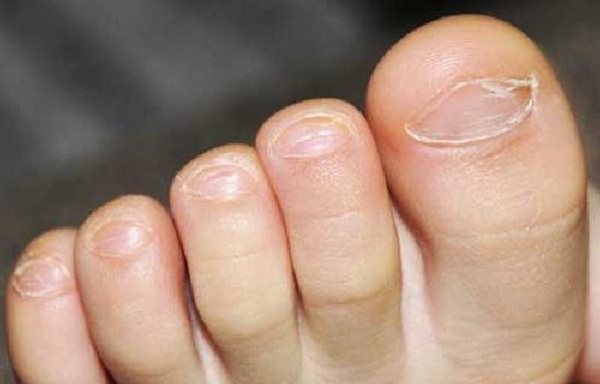
Antifungal varnishes are one of the best weapons in the fight against the disease. The disadvantage of such varnishes is that they are mainly used only from the age of 14.
Before applying antifungal varnishes, it is necessary to carry out a number of preparatory actions:
- Pour hot water into the bath, adding a teaspoon of soda;
- Wash your hands and feet with laundry soap containing alkali to remove fungus from the surface of the nails;
- Steam the exfoliated areas of the nail plates, leaving for up to 15 minutes;
- Dry your nails with a napkin;
- Remove peeling, fungal-affected areas using a disposable nail file to avoid secondary infection in healthy areas;
- Degrease the surface with a cotton swab dipped in an iodine (aqueous) solution;
- After this, apply the composition according to the instructions.
We suggest you read: Why does the big toe go numb and what to do?
But still, among all, two drugs can be distinguished that are excellent weapons against nail parasites and are suitable for children:
- Batrafen - prescribed to children over 10 years of age. The duration of treatment is 3 months. The average price is 2200 rubles. The product should be applied to the nail plate in three stages: the first month - every other day;
- second month - 2 times a week;
- third month – once a week.;
Batrafen
Oflomil
Creams and ointments are effective in the initial stages of the disease, since they act only on the affected area, suppressing the spread of microbes.
They are applied in a thin layer to the nail plate and affected skin. First you need to wash and dry the affected area of the skin, and treat your nails with a special nail file.
The most effective ointments for treating fungus for children are:
- Clotrimazole - fights all types of fungal diseases. In small quantities it inhibits the growth of pathogenic microbes, and with increasing concentration it destroys the fungus completely. This medicine should be used for a month, even if obvious signs of infection have disappeared. Apply 2-3 times a day in a thin, even layer to the affected area and around it. There are practically no side effects, but it is not recommended for children with allergies and under the age of 3 years. It should not be used together with antibiotics, as Clotrimazole stops their action. Average price 40 rubles;
- Nizoral has a wide range of actions. The active substance of the drug treats the affected areas from the inside, as it easily penetrates the tissue. Apply the cream 2 times a day, occasionally in a thick layer, covered with a gauze bandage. The duration of treatment is individual for each patient, usually from 6 to 9 months. The exception is advanced cases, in which case treatment may take a year. Prescribed to children from three years of age. Not recommended for children with lactose intolerance. The cost of the cream is 500 rubles;
- Exoderil is a very good remedy, but it must be used carefully. This substance should not be applied to wounds and calluses, and the instructions must be strictly followed. It should be applied to the affected areas and the skin around them for a month once a day. Children are prescribed from 10 years of age. The average price is 500 rubles.
Clotrimazole
Nizoral Exoderil
Antifungal sprays are one of the most popular methods of fighting infection because they are non-contact and easy to apply.
The modern pharmaceutical market offers many drugs, but the two best of them are worth noting:
- Thermikon - this product has a wide spectrum of action, it is a fairly effective medicine, a small amount is enough to get rid of fungi completely. The drug should be used no more than twice a day and only for children over three years of age. The course of treatment is one week. The medicine should not be allowed to get on the mucous membranes; this can cause a corresponding reaction in the body - dizziness and nausea. You can purchase the spray for 260 rubles;
- Bifosin is one of the few medications that is highly effective even in cases where other antifungal drugs do not help. The reason is that infectious agents can only in rare cases develop resistance to bifonazole, the active ingredient in the spray. This drug is used to treat the affected areas of the nail once a day for 2-4 weeks. Another advantage is that the medicine can be used from birth, but under the careful supervision of a doctor. The average price is 120 rubles.
Thermikon Bifosin
Solutions against onychomycosis are the only external remedy that acts not only on the surface of the nail plate, but also inside.
The medicinal ingredients of the solution accumulate in the nail and prevent the fungus from spreading.
For children prescribed:
- Fukortsin is a combination remedy that has a strong antifungal effect. Fukortsin is safe for children from birth if small affected areas are treated. However, it should be used only after consulting a doctor, as there is a possible risk of an allergic reaction. Apply to affected areas 2-3 times a day. The solution has a strong tart odor. This is a fairly budget-friendly product, the cost of which is 40 - 90 rubles.
- Candide is a broad-spectrum drug that destroys most fungi. It is excreted from the body with bile. Apply to clean skin 2-3 times a day for a month. This drug is prescribed even to newborns. The cost is 120 rubles.
Fukortsin Candide
Medicines in tablets are prescribed only when the disease is advanced and conventional remedies do not help. Nowadays, there are many tablets against fungus, but not all are suitable for children.
Tablet medications must be prescribed by a specialist and his recommendations must be strictly followed.
Most often, pediatricians recommend taking:
- Terbinafine - acts at all stages of the lesion, but at the last stage longer treatment is recommended, which can take from 6 to 9 months. Can be used for children from three years old. You should take half a tablet once a day. The drug causes almost no side effects; digestive system disorders are rarely possible. The cost is from 200 rubles;
- Fluconazole - according to experts, this remedy is the most effective in combating toenail fungus in children. It is used from the age of one. For children, the dosage is calculated by the doctor based on the child’s weight category. However, it can cause serious side effects such as allergies, migraines, and seizures. Therefore, it should be used with caution. The drug is inexpensive, the average cost is about 30 rubles.
Terbinafine Fluconazole
Diagnostics
Atopic dermatitis in a child photo
Diagnosis of fungal diseases in children is often complicated by unclear manifestations of the disease and the presence of concomitant pathologies (allergies, diathesis, diaper dermatitis, atopic dermatitis, etc.). Therefore, the main direction of diagnosis is to exclude diseases that have symptoms similar to mycoses.
For this purpose, clinical, bacteriological, immunological tests are carried out, the purpose of which is to exclude the influence of the immune system, gastroenterological and endocrine diseases and other factors that may be both the cause of symptoms and the need to adjust the treatment regimen for the fungus.
Treatment
Lichen planus of the nails in a child
You can treat skin fungus on a child’s body in different ways, the main thing is that this process takes place under the supervision of a pediatrician. Self-treatment of fungal diseases in children is carried out taking into account the pathogen that caused mycosis, the age of the child, the presence/absence of concomitant pathologies and other factors.
Drug therapy uses drugs that suppress the activity of pathogenic fungi and cause their death. The specific drug, dosage, frequency of administration and duration of treatment are prescribed by the attending physician. For example, candidiasis on a child’s bottom is treated with a solution of furatsilin, which is freely sold in pharmacies.
Remember! Before giving your baby any medications, you should consult your pediatrician.
For severe inflammatory processes caused by fungus or secondary infections, antibacterial and anti-inflammatory drugs are recommended. Depending on the severity of the inflammation, prescriptions may include systemic medications (taken orally as tablets, syrups, or drops) or topical medications (applied directly to the skin).
In case of severe itching that disrupts the child’s sleep and appetite, antipruritic drugs, antihistamines and home treatments (soda baths, bran decoction lotions, etc.) can be prescribed.
Folk remedies in the treatment of fungus
You can also get rid of fungus using traditional medicine:
- Tea tree oil - rub the oil well into the child’s feet before bedtime and put on clean, cotton socks. The more often you do this, the faster the disease will pass;
- Kalanchoe - leaves of the plant are applied to the nail overnight, first secured with a plaster or bandage;
- Onion - cut it into small pieces and wipe the damaged areas;
- Wormwood - take half a kilogram of herb and infuse it with 2 liters of water in a water bath. Then the baby needs to thoroughly steam his feet with this decoction;
- Herbal decoctions - chamomile, oak bark and calendula are boiled for five minutes and allowed to brew. The strained broth is used to wipe the feet;
- Palm oil - the oil is mixed with burdock extract in a one to one ratio. This product is applied to the nails at night, secured with a band-aid;
- Brewed coffee is the fastest way. You need to soak your child’s feet in a strong, hot drink. This method eliminates the child from the disease forever;
- Iodine - rub the damaged nail with five percent iodine twice a day. You can also steam your baby’s feet for ten minutes in boiling water with a couple of drops of iodine4
- Hydrogen peroxide - take a three percent peroxide solution and mix it with three percent vinegar in equal quantities. You need to soak your baby’s feet in this product for a few minutes, and then just rinse with water.
Traditional medicine can be used only with the permission of the attending physician as an addition to the main treatment. Examples of the most popular folk remedies for treating children's foot fungus:
- decoction of milkweed, wormwood;
- Brewed coffee;
- compress of onion and garlic pulp;
- ointment with the consistency of sour cream made from soda and water;
- a mixture of one raw egg and one tablespoon of vinegar (vegetable oil);
- lilac tincture;
- wild garlic juice;
- compress of rowan leaves;
- rubbing solution of 30 grams of eucalyptus oil and 100 grams of Kalanchoe.
In the initial stages of fungus, warm foot baths with sea or regular kitchen salt are effective. We must not forget that any of the folk remedies can cause allergic reactions in the baby. If an allergy appears, as well as a general deterioration in the child’s condition, use of the product should be stopped immediately. Otherwise, an allergic reaction can significantly complicate drug therapy for the fungus.
the skin becomes red, inflamed, the skin is very itchy, a burning sensation is felt, blisters, ulcers, and erosions appear. The skin cracks, pain occurs when walking and wearing shoes. Between the fingers, the upper layer of the epidermis peels off greatly, scales are formed, saturated with fungal spores - this is the causative agent of infection (the scales remain in socks, on carpets, in shoes, getting on the skin of other family members and thus spreading).
Usually, the fungus is first localized in the area of the ring finger and little finger. The longer the fungus parasitizes on the child’s feet, the wider the affected area becomes.
We suggest you read: Increased temperature in the anus
Symptoms of nail fungus in children are manifested by the following features:
- you can notice that the nail plate has visually changed - small longitudinal or round white spots have appeared, the nail has become embossed;
- areas of redness and swelling can be seen on the fingertips;
- As nail fungus develops in children, the nail plate becomes thinner or thicker, and parts of it begin to peel off;
- the color of the nail changes, the nail plate may peel off from the nail bed;
- the nail loses its strength, crumbles, flakes, and collapses.
With each new stage, the fungus manifests itself with more noticeable symptoms. So, if in the first stages of onychomycosis infection it is almost impossible to visually diagnose the disease, then at the last stage its symptoms are obvious. You can see exactly what this disease looks like in children in the photo.
As for traditional methods of treating foot fungus in children, they can only be used with the recommendation of a doctor. And if a parent independently decides to try any remedy, this issue should be agreed upon with a specialist.

Foot baths with a decoction of milkweed are effective. To prepare the infusion, take 300 g of milkweed herb and pour a glass of boiling water over it. The milkweed is infused in a steam bath for half an hour. Next, the strained infusion is poured into a bowl of warm water. The child should steam their feet in this solution for 15-20 minutes, after which they should be rinsed with clean water and dried thoroughly with a soft towel. Additionally, you should treat your feet with antifungal ointment.
You can make your own antifungal ointment. To do this, 1 chicken egg is mixed with 1 tbsp. a spoonful of vegetable oil (can be replaced with vinegar). Rub the mixture on the child’s feet before bed, wrap them in polyethylene, and put on woolen socks. The ointment is stored in the refrigerator. Storage duration is no more than 3 days.
Foot baths with table and sea salt are used as additional actions to the main treatment. To do this, both types of salt (100 grams each) are thoroughly dissolved in hot water (1 liter), after which the child should steam the legs well. Such baths relieve itching and speed up recovery.
Complications
Cutaneous erythema of the newborn
Mycosis in children poses the greatest danger from the point of view of the formation of immunity and its characteristics. During their life activity, pathogenic fungi release toxic compounds. They destroy the upper, protective layers of the skin and can enter the general bloodstream. The toxic effect of these substances destabilizes the child’s immune system, which is not yet able to resist such aggression.
As a result, pediatricians note that children who have suffered from mycoses for a long time are much more likely to develop immune hypersensitivity - an allergy, which already has its own, and often severe, consequences.
Types of mycosis in children
Doctors warn! Skin problems, constant rashes of unknown nature, this means that your body is signaling the presence of parasites. Parasites in the body weaken the immune system, poisoning a person with poisons... In order to eliminate skin problems, it is necessary to cleanse the body of parasites and toxins released by them. A country-famous doctor spoke about a new effective remedy against parasites... Find out how to get rid of parasites once and for all with the help of a new natural remedy...
source: gribkovye-zabolevaniya.com
